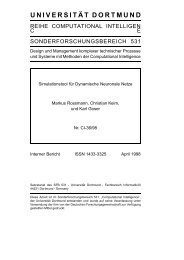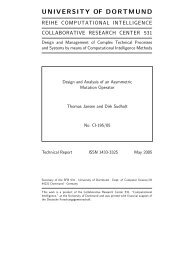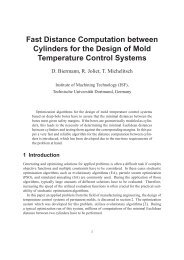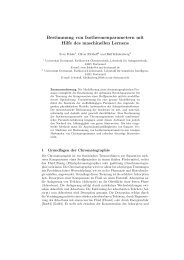Self-Adaptive Genetic Algorithms with Simulated Binary Crossover
Self-Adaptive Genetic Algorithms with Simulated Binary Crossover
Self-Adaptive Genetic Algorithms with Simulated Binary Crossover
You also want an ePaper? Increase the reach of your titles
YUMPU automatically turns print PDFs into web optimized ePapers that Google loves.
(?0:5x(1;t)<br />
suggested.<br />
[x(1;t) i+1:5x(2;t)<br />
2 <strong>Genetic</strong> <strong>Algorithms</strong> <strong>with</strong> <strong>Simulated</strong> <strong>Binary</strong> <strong>Crossover</strong> (SBX)<br />
There exists a number of real-parameter GA implementations, where crossover and mutation operators<br />
are applied directly on real parameter values. One of the early implementations was by Wright (1990),<br />
where a linear crossover operator created three solutions(x(1;t) i+x(2;t) i),(1:5x(1;t) i?0:5x(2;t) i), and<br />
i)from two parent solutionsx(1;t) iandx(2;t) iat generationtand choose the best<br />
two solutions as children solutions. Goldberg introduced the concept of virtual alphabets in the context of<br />
real-coded GAs (Goldberg, 1991). Eshelman and Schaffer (1993) have introduced the notion of interval<br />
schemata for real-coded genetic algorithms and suggested a blend crossover (BLX- ) operator. For two<br />
parent solutionsx(1;t) i?(x(2;t) iandx(2;t) i?x(1;t) i),x(2;t) i(assumingx(1;t) i+(x(2;t) i?x(1;t) i








